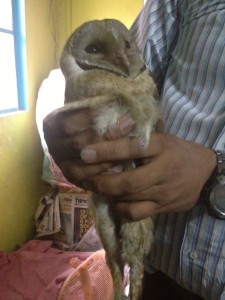In Delhi, two brothers become saviors of wild birds


DELHI -- Nadeem Shehzad, a businessman, has six owls in his bedroom, two Sparrowhawks clinging to the curtains in his living room, and about 120 Black Kites -- plus two Egyptian Vultures -- roosting on the roof his home near Chawri Bazaar in the old part of India's capital city.
“The one with the red eye is a male and the one with the yellow eye is a female,” he said of the Sparrowhawks as flew overhead and settled on the refrigerator.
The male had a leg fracture and the female had her wings stuck by adhesive glue. The birds are now recovering. “Their claws are really sharp,” said Shehzad. “They can hurt you when you’re treating them."
Shehzad, 34, and his brother Mohammad Saud, 31, are running a self-funded operation called Wildlife Rescue in their home in Old Delhi, which is characterized by large crowds squeezing through narrow lanes of packed and colorful bazaars.
It is also an area famous for kite-flying, especially during the weeks around India's Independence Day on August 15. However, a rarely addressed problem of kite flying is the significant number of birds that are injured by the sharps strings of the kites.
Almost every day, the brothers find birds that are cut or bruised by kite strings. “They are wild birds so nobody treats them and they die of thirst and hunger after the injury,” said Saud.
Although the Jain temples run several bird hospitals in the city, such as the famous Charity Bird Hospital, established in 1929, a central tenet of the Jainism religion is to respect all natural life. For that reason, strictly vegetarian Jains cannot treat carnivorous birds. Some of them even wear masks to avoid killing insects while inhaling.
“The main problem is that we cannot allow meat in our facility,” said Dalip Yadav, a supervisor of the Charity Bird Hospital. “Jains cannot kill one animal to feed another.”
The upshot is that there are few facilities in Delhi where birds of prey, also called raptors, can receive treatment. Only one organization, called Wildlife SOS, attends to birds of prey as well as bears and snakes.
So the Jain hospital sends the carnivore birds to the two brothers, who have gained a reputation in the local community over the past few years. “Since nobody treats them, we bring every raptor to our place,” said Saud.
Ever since they were children, Shehzad and Saud have been concerned about injured birds, which they saw lying on the roads of Delhi. But it was only ten years ago that they decided to act by bringing the injured birds home. “The birds started getting cured and flying away,” said Shehzad. “This really boosted our confidence.”
 The brothers developed their own expertise in treating these injured by birds by gathering information from books and the Internet, as well as consulting doctors for tougher operations like implanting stainless steel screws to join bones together. “There is very little training for this here. So we taught ourselves,” said Shehzad.
The brothers developed their own expertise in treating these injured by birds by gathering information from books and the Internet, as well as consulting doctors for tougher operations like implanting stainless steel screws to join bones together. “There is very little training for this here. So we taught ourselves,” said Shehzad.
The majority of birds, which the brothers bring home for treatment, are Black Kites that are cut by kite strings. “We get about three to four cases a day,” said Saud.
But they also treat splintered bones and fractures caused by road accidents, and attacks by monkeys. Some of the injuries are so brutal, the brothers said, they have to euthanize the birds.
Wildlife Rescue is presently a goodwill venture. Nobody pays for the treatment of wild birds. So the brothers, who run a business making liquid soap dispensers, put money from their day job into their bird venture. They said it costs them around Rs.25,000 (US$500) a month, which includes payment for equipment, fuel and meat to feed the birds.
“Financially, this is becoming difficult for us because we are getting too many calls,” said Shehzad. “And our business has been badly hit by the recession. We are looking for donors [in order] to do better work.” They plan, in the next couple months, to build a website that will help them solicit such donations.

The brothers, who currently carry out operations in their business office, want to develop a proper shelter for the birds to treat and keep them until they recover.
The brothers use basic equipment like needle holder, battery-operated drill machine, wires and scissors. But they really need a digital X-Ray machine, which is too expensive for them to buy. “We have to cut the bird open to see how the bone is injured. We feel handicapped without an X-Ray machine,” said Shehzad.
Shehzad and Saud scout around for injured birds in a 50- kilometer radius of where they live. In 2010, they also set up a helpline number. And now they get about 10 calls a day. Many of these are from people who see birds, especially owls, as a bad omen and want them removed from their locality.
“On the calls we do not compromise. We even leave our office and rush to attend the birds,” said Shehzad. “Before we go to bed we finish all the calls even if it takes till 3am.”
After the birds recover, they are free to leave. An eight feet grill surrounds the roof where the birds stay. “If they can fly over that, they are strong and free to go,” said Shehzad. And sometimes, the brothers take the birds to an open space and release them.
Photos: Wildlife Rescue, Betwa Sharma
To help, please dial the Wildlife Rescue Helpline number: 91 9810029698.
This post was originally published on Smartplanet.com
